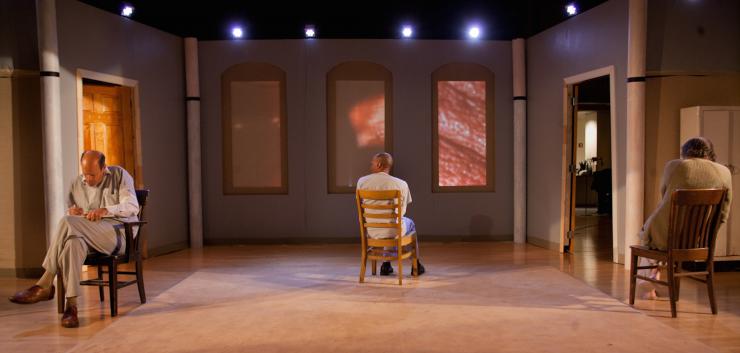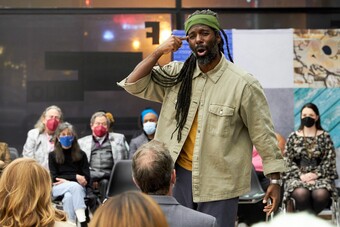Site Work to WorkSites
Peculiar Works Project Illuminates the Insides of the City
Theater that is inspired and informed by the spaces in which it is performed is the essence of Peculiar Works Project (PWP). Conversations between space and storytelling have thrilled PWP founders Ralph Lewis, Catherine Porter, and Barry Rowell in over one hundred performances they have crafted and staged since 1993.
The city is their playground and scripts, locations, librettos, and other stories of the past provide fodder for their active imaginations. Among the sites for their “theatrical conversations” have been the cavernous downtown Post Office building across from Penn Station (Manna-Hata in 2013), the Village as multiple points of interest in Off Off Broadway history in a walking tour (West Village Offstage in 2006 and East Village Offstage in 2007), and most recently the Judson Memorial Church sanctuary in which they told a story of mental health treatments that went too far (3Christs in 2014).
The three founders convened at Judson Memorial Church during the run of 3Christs to discuss their company, its goals and successes, and what projects are in the pipeline.
Company Origins and Philosophy
Workplace frustrations (involving an Off Broadway theater where they all once worked) and discussions about how they’d run things when they were in charge inspired the founding of PWP.
Ralph mused on the components of their project development routines:
We start with good core concepts and then to see where they could go we developed a developmental program called WorkSites. Once we get a draft of something roughed out, we have that program to get it up on its feet.
Catherine clarified: “We’re very project based. Sometimes we do WorkSites in a theater. Some of our WorkSites have been done under sort of residency; it’s not necessarily in the same space where we’ll be doing a project.”
The community they build is essential. “Collaboration is important to us, and we don’t want it to be just the three of us, so we try to bring in different groups of artists,” Ralph reflected. They convene, and then they get out of the way. “We’re driving this train in the pre-production. We’re doing everything. And then we start bringing on team members. And once you get these designers involved, you have to let them do their work.” Catherine added, “We remake the team for each project.” Ralph underscored another reason for this. “We decided when we started a company that it would not be membership based. If people came out and worked with us it would be because they wanted to not because they were obligated to.”
To awaken audience to ideas, and awaken audience to environment, to space, to site—that's what we want to do with all of our projects.
Site-Focused Work and Why They Love It
Catherine spoke of buildings and places that interact with storytelling, and how what the audience takes away is part theater, part history, part architecture, and part archaeology.
We want to create performances that are about ideas and we want to do it in such a way that awakens a space and awakens an audience to a space. To awaken audience to ideas, and awaken audience to environment, to space, to site—that's what we want to do with all of our projects.
Ralph helped draw the distinction among the “site-specific,” “site-responsive,” and “site-based” work that PWP does.
Site-specific work—3Christs might be close to that because we have been developing this work with this space in mind for a while. Site-responsive work addresses how a site and the work respond to each other. And sometimes it’s just cool to do something that’s site-based, not in a damn theater—to take audiences somewhere different, to kind of shake up the perceptions about where a performance can happen.
There are costs to producing site specific work that Ralph clarified.
Usually when you do a play, you hang the lights and you build the set—you’re ready to go. But we don’t just build the set. We build the seating, the house, the lobby, the front of house, the concessions, the box office, even the dressing rooms. It’s a lot of manual work. It takes a lot more to do site-specific work—a lot more energy, a lot more time, a lot less sleep than just doing the show.
Catherine underscored a huge benefit of the work as the ongoing resonance for New York City residents. “You have an intimate knowledge of the space that’s something that only people who work there for their day job would have. It’s like the ghostly layers are there, in the way that New York in general is layer on top of layer of history.” Ralph liked the way this strategy allows New Yorkers “a chance to see some of the insides of their city.” Catherine reflected, “It’s sort of impossible to walk by interesting buildings or sites and not think about a project for that site.”
The Evolution of 3Christs at Judson Memorial Church
The team has worked at Judson Memorial Church since the early years of PWP. Catherine recalls the beginning:
We first came to Judson in the mid-nineties. We were doing a large scale haunted house and were looking for the right location. Ralph was walking by Washington Square Park and thinking about Judson and its history of supporting the arts. He knocked on the door, and a woman with short hair and a nose ring answered—the assistant minister at that time. She was completely interested in what we were doing, and we staged BIG ART in Small Spaces here in 1996. 3Christs is our fifth project that’s an affiliation with Judson.
It started with Santa Claus. Ralph was working with the actor Charles Edward Hall eighteen years ago in Atlantic City. Hall, who has played the Radio City Christmas Spectacular Santa Claus for over twenty-five years, talked about this study that he wanted to adapt into a play, about therapeutic experiments with three men who believed they were Jesus Christ at Ypsilanti State Hospital in the 1960s. When initial conversations about adapting the study didn’t go anywhere, Ralph asked Hall if he could take a stab, and he and Barry started adapting it.

Photograph © 2014 Jim R Moore / Vaudevisuals.
The work was in a drawer for a while after the initial workshops until about five years ago when PWP pulled it out again. The effort to clear the rights took some time as the doctor’s widow dealt with health issues and the estate fielded competing offers for rights to the source material. Fragments of the source material have emerged in surprising places. Catherine recalls how she and Barry were shocked when they identified direct quotations from the book on the Ypsilanti study in the script of the 1972 film The Ruling Class.
The Ypsilanti study idea was worked on in fits and starts over the ensuing years. According to Ralph,
We workshopped a piece in the balcony here at Judson, and focused on the three Christs. We decided that we had to have the doctor be a part of the story or you just have three crazy guys. You must come to understand that the doctor was playing God just as much as any of them were.
Catherine mused about after-effects. “Maybe people will read the book. That would be my take away—if someone saw our play and wanted to know more about the actual events that would make me happy.” Ralph spoke of the company post-show discussion as part of a bigger picture.
Rather than just do a play, we want to have a larger production—so making books available is part of that, having the Thursday night talkbacks are part of that. One panel speaker has a book called How Culture Shapes Madness and another panel includes a couple of women who are psychiatric nurses to talk about how treating mental illness has changed over the decades. So one will be about belief and one will be about mental health.
What's Next and Honoring Home
The group plans to revisit several of their past projects—Manna-Hata and Don Quixote. They also discussed several developing works. A new adaptation of The Black Crook—what many regard as the first American book musical and perhaps the first evening-long dance concert. Floydata inspired by a tiny West Texas town called Floydata that tells the fictional story of two women who start a Dada cabaret. A new piece they work shopped in early 2014 called Nobody Brings Anything Small into a Bar, a “collage play of lots of different events taking place in a bar” according to Catherine, and which has the promise of being quite portable, adapting the work to the atmosphere of any bar in which it is performed. And perhaps a production of an unfinished play called The Violinist by Leonard Melfi, an alcoholic who died twelve years ago of a heart attack in the hallway of a New York hospital, from which his family has won a huge settlement. The provenance is provocative, the play unfinished—perfect fodder for the PWP treatment.












Comments
The article is just the start of the conversation—we want to know what you think about this subject, too! HowlRound is a space for knowledge-sharing, and we welcome spirited, thoughtful, and on-topic dialogue. Find our full comments policy here